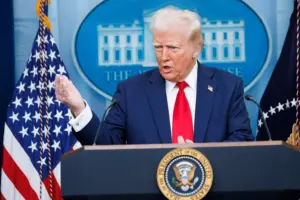The Federal Reserve has decided to keep interest rates unchanged as it closely monitors inflation and the impact of new tariffs introduced by President Donald Trump. Minutes from the January meeting of the Federal Open Market Committee (FOMC), released on Wednesday, reveal that officials remain cautious about cutting rates further until inflation shows more substantial signs of decline.
The Fed’s key policy rate remains at its current range of 4.25%-4.5%, following three rate cuts in 2024 that totaled one percentage point. Policymakers agreed that the current policy stance is “significantly less restrictive” than before the rate reductions, giving them time to assess economic conditions before making further adjustments.
Concerns Over Tariffs and Inflation
A major discussion point in the Fed meeting was the potential inflationary impact of Trump’s trade policies. The president has already implemented certain tariffs and recently hinted at expanding them further. He has proposed a 25% tariff on automobiles, pharmaceuticals, and semiconductors, measures that, if enacted, could significantly impact consumer prices and global trade.
Officials expressed concern that businesses might pass the higher costs from tariffs on to consumers, further elevating inflation. Some policymakers warned that restrictive trade and immigration policies could put upward pressure on prices, making it harder for inflation to return to the Fed’s 2% target.
Despite these concerns, the Fed minutes also noted optimism regarding economic growth. Some officials believe that deregulation and potential tax cuts under Trump’s administration could stimulate business investment and economic activity, balancing out some of the negative effects of higher tariffs.
Uncertain Rate Cut Timeline
The FOMC emphasized that rate decisions will be made on a meeting-by-meeting basis, without a fixed timeline for reductions. Inflation data has been mixed recently, with consumer prices rising more than expected in January, but wholesale price trends suggesting softer inflationary pressures.
Fed Chair Jerome Powell has refrained from speculating on how tariffs will influence monetary policy, but other officials have acknowledged that Trump’s policies could delay rate cuts. Market analysts now anticipate the next rate reduction may come in July or September, depending on how inflation trends in the coming months.
The Fed remains focused on employment, inflation, and broader economic stability as it navigates the uncertain impact of fiscal and trade policies. The coming months will be critical in determining whether inflation cools enough for the Fed to ease its policy stance.





